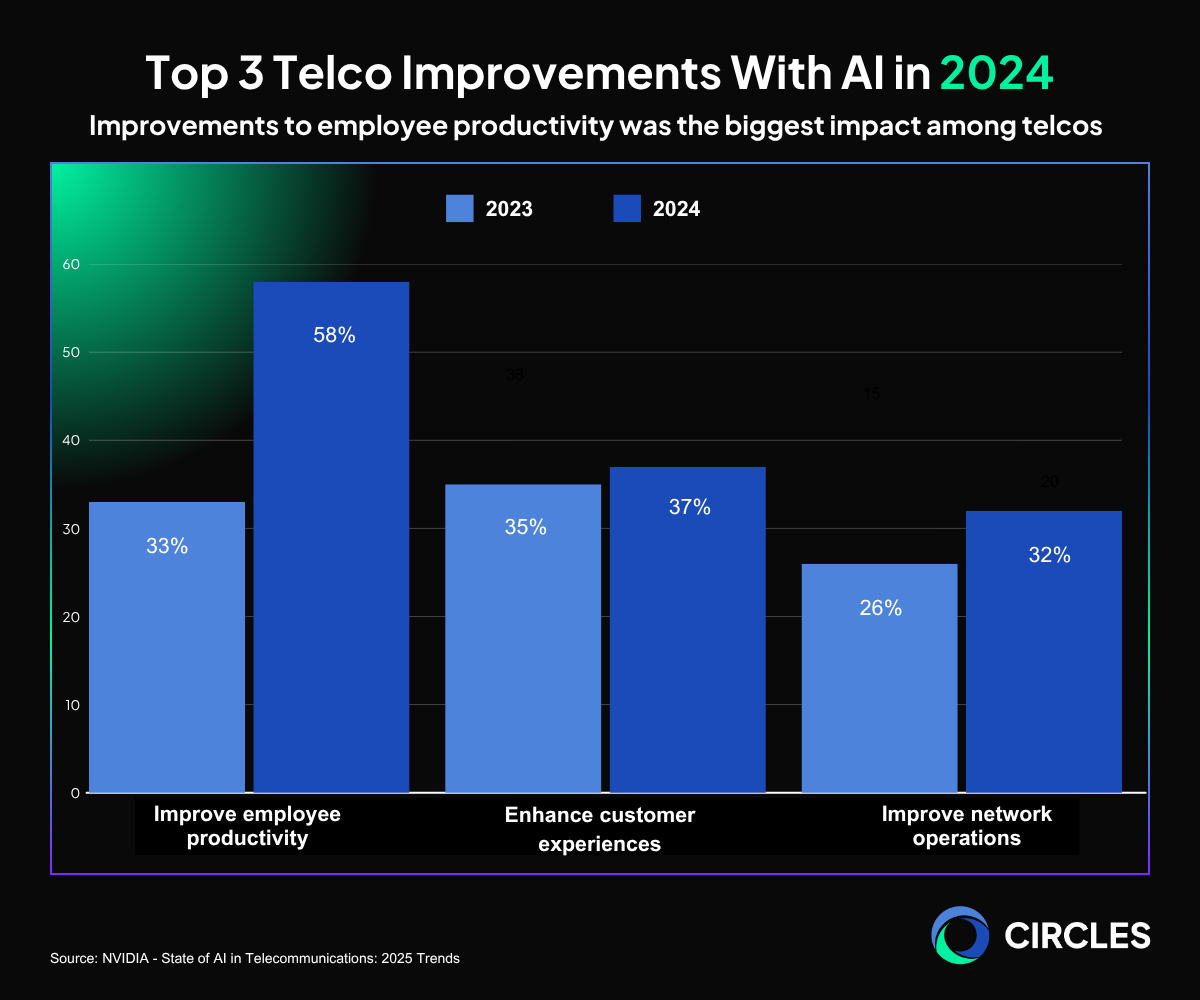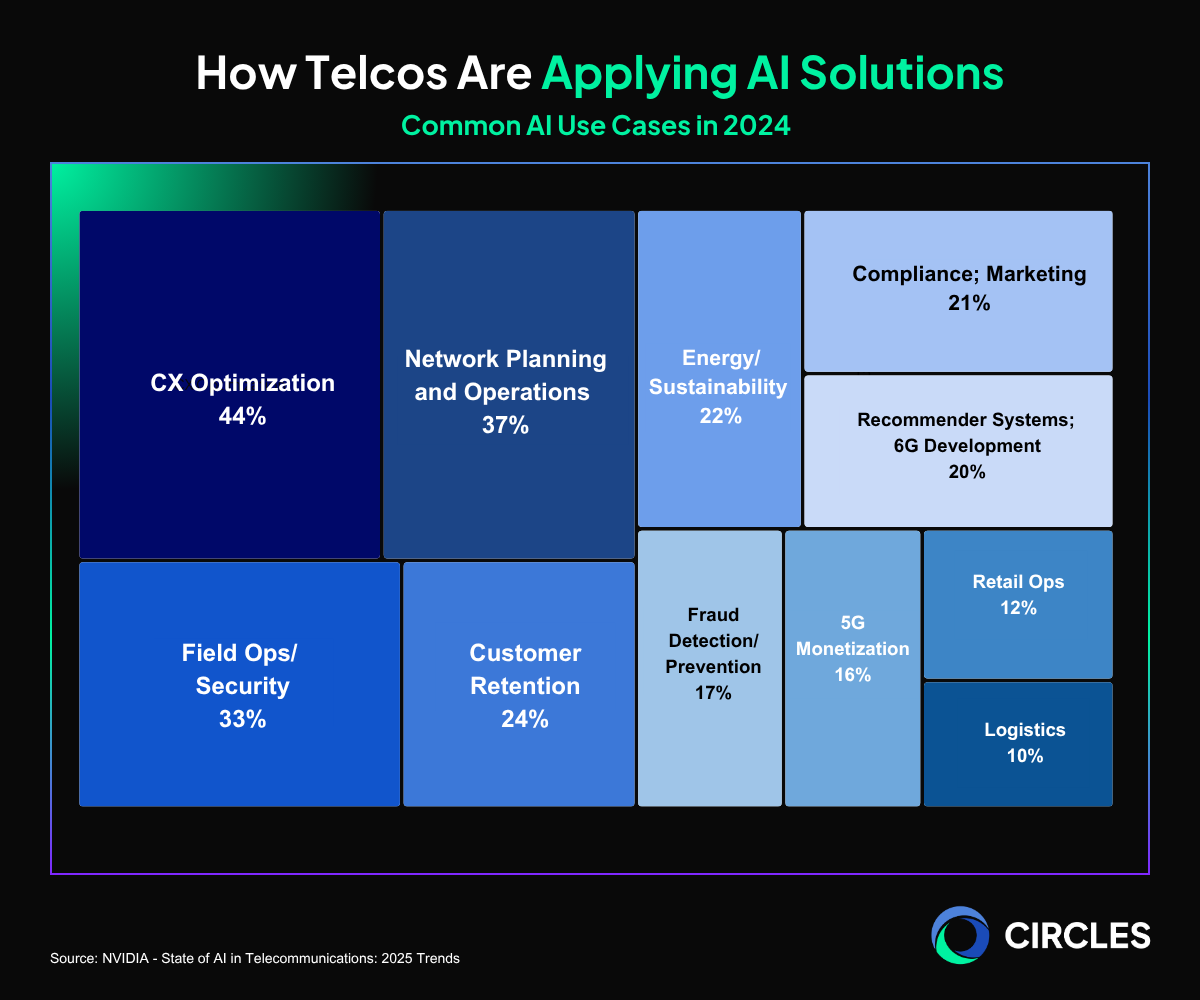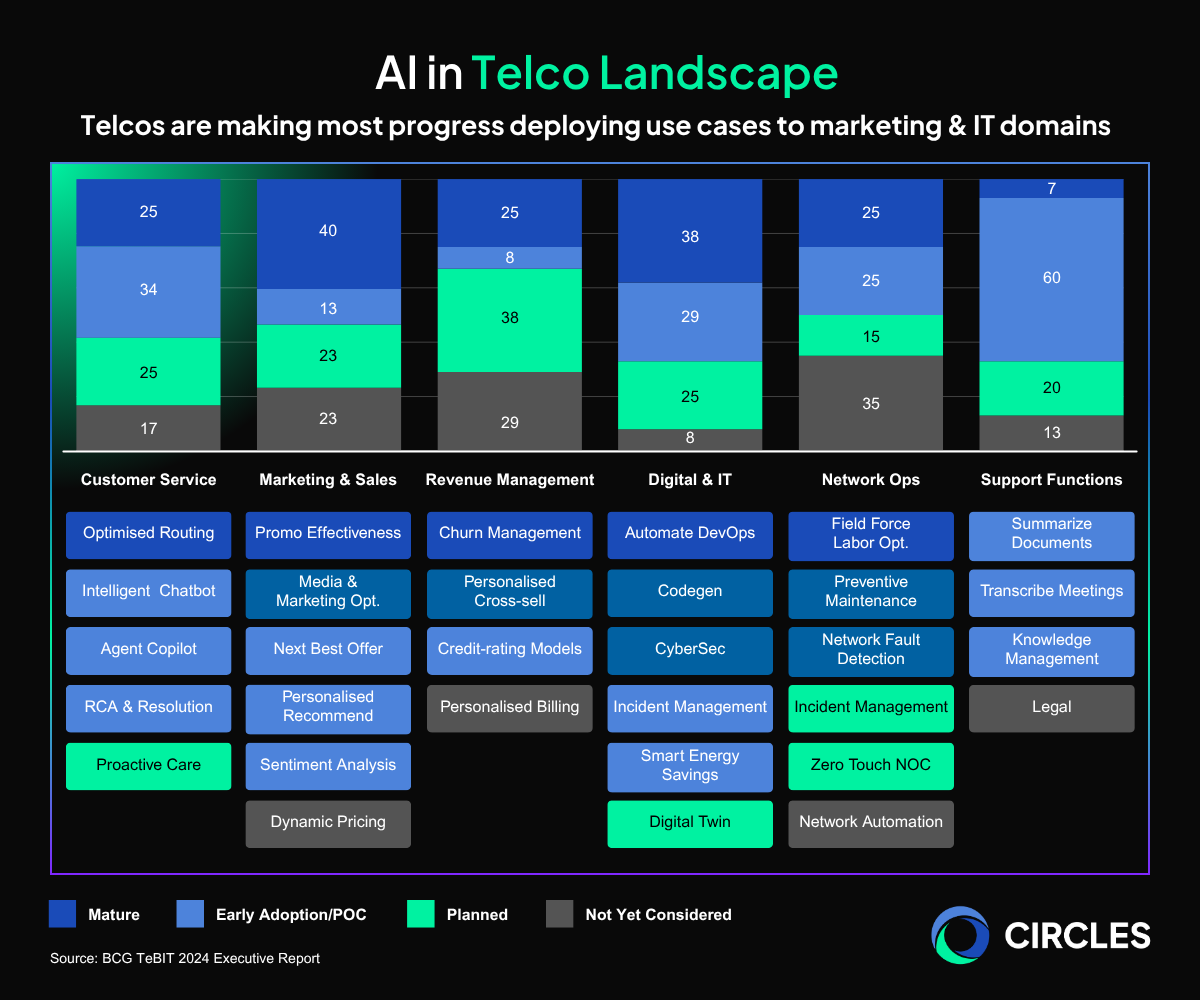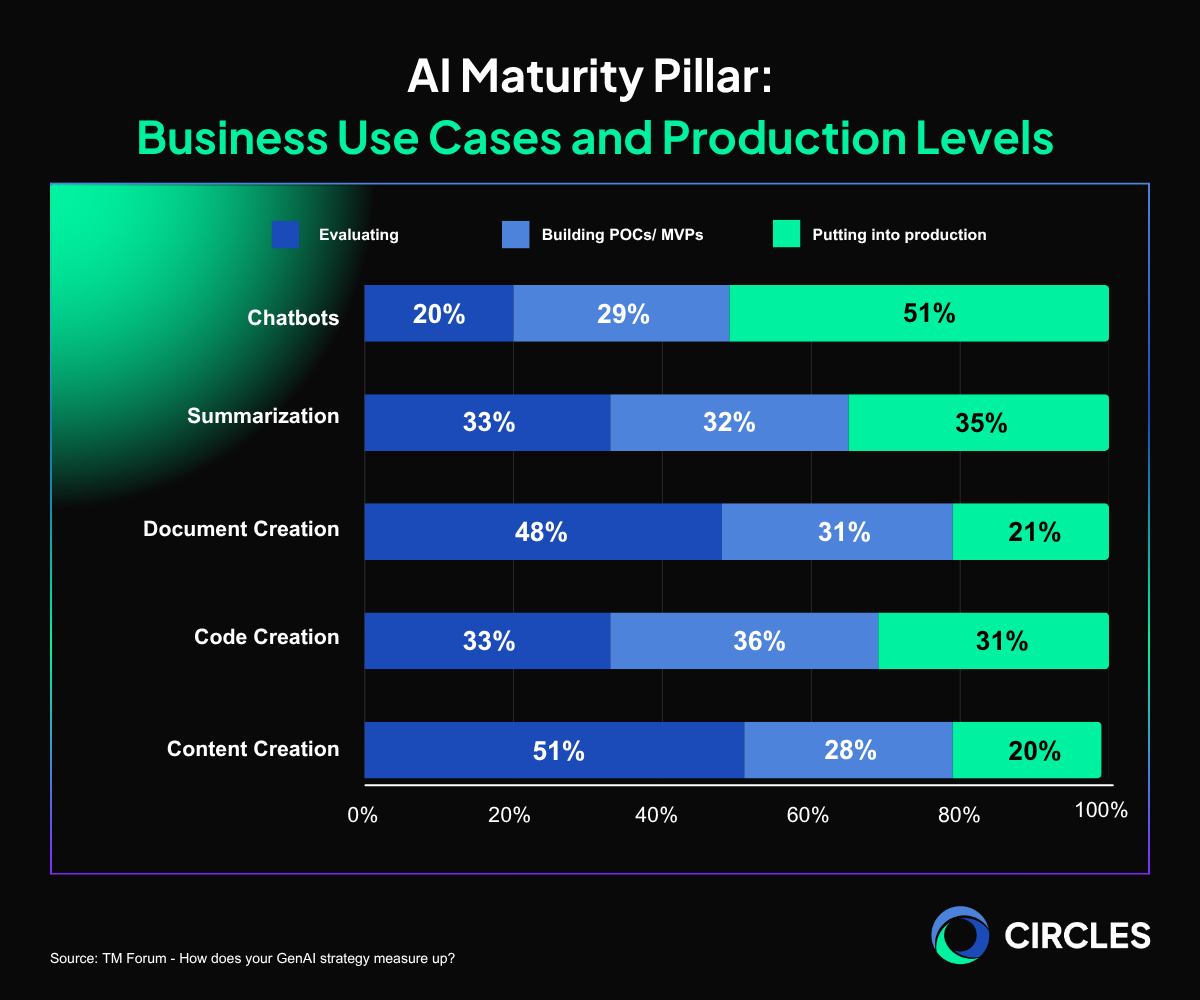.png)

Cutting Through The Noise in Telco AI
Artificial Intelligence (AI) promises a lot of business results for telcos bold enough to fully embrace them, but as with all technology upgrades, there is also the risk of investing in the wrong ideas.
AI is now firmly embedded in the telecom agenda, with shareholders expecting telco operators to use it to protect margins and create growth, while customers place greater demands on customer experiences. Telcos have responded strongly with 97 percent of telcos are adopting or assessing AI, and nearly half (49 percent) already use it in operations.
The challenge for CEOs here is how to separate signals from noise. Not every use case will scale, and not every AI-related announcement translates into competitive advantage. This report compiles where the value that telcos can gain from AI lies and how following successful use cases could guide a telco’s AI use case priorities.
Industry Benchmarks: What’s Working and Where The Industry is Focusing
In 2024, Operations Efficiency Was The Biggest Improvement From AI
NVIDIA’s 2024 industry-wide study echoes the pattern of improved employee productivity being a main benefit, with 58 percent of respondents citing it as their biggest benefit of AI adoption. Some examples of efficiency improvements include faster code generation for IT teams and chatbots that can take on easier customer service queries, freeing up customer service agent manhours. This was followed by enhanced customer experience (37 percent) and improvements in network operations (32 percent).1

The past two years have shown that more telecom operators are taking a mature approach to AI investments. What began as opportunistic pilots in marketing and digital and IT support in Europe in 2023 is now expanding into network operations and customer experiences.1 Yet scaling remains uneven, and maturity levels vary sharply by function.
Customer Experience Is a Top Priority, With Network Planning and Operations Coming in Second
Telcos around the world have been focusing their AI investments across a wide spectrum of use cases. Considering how fast the telco industry moves, this report consolidates findings across various industry landscape reports from NVIDIA, TM Forum’s Generative AI Maturity Interactive Tool (GAMIT) Report, and BCG’s Telco IT benchmark (TeBIT).
Overall, telcos have been largely focusing on the following use cases:
NVIDIA’s Findings: Customer Experience, Network Planning, and Field Operations
NVIDIA’s report highlighted that telcos have been focusing primarily on customer experience optimization, network planning and operations and field operations or security. This report surveyed 450 telecom professionals globally between October and November 2024.
Other use cases include the following:1

NVIDIA also reported that generative AI (GenAI) is rapidly entering the mainstream. Nearly half of operators (49 percent) say they are actively adopting or evaluating GenAI use cases, and 84 percent of those exploring GenAI plan to offer GenAI services to customers suggesting that telcos are now more confident in GenAI’s ability to create commercial value on top of the operational efficiencies it has been generating.1
The most popular way to generate commercial value through GenAI was to offer generative software-as-a-service (SaaS) solutions, with 52 percent of telcos planning to do this. One example of this is povo AI and Circles AI which is part of the Circles Xplore offering, AI assistants embedded directly into a tab on the telco app.
BCG TeBIT: Marketing and Sales & Digital and IT Get The Most Attention
This marks a shift compared to BCG’s latest TeBIT benchmark report that focuses on European operators’ 2023 IT spending and performance. BCG’s TeBIT is jointly developed by the Community for Telecom Professionals and Boston Consulting Group (ETIS).2
The TeBIT report mentioned that European telcos made the most progress deploying use cases in marketing and sales and digital and IT. 40 percent of BCG respondents reported that they were mature in terms of marketing and sales AI deployment and 38 percent reported being mature in terms of Digital & IT.2
Notably, many telco respondents mentioned that they are in the proof of concept stages for customer service, network operations, and support function use cases which also ties in with TM Forums’ 2024 findings.3

Interestingly, telcos in Europe seem to have been experimenting with AI in their own way. BCG and ETIS compiled a list of common use cases based on BCG experience, discussions in the ETIS community, and out-of-the-box solutions covering some broad areas including customer service (e.g. chatbots), marketing and sales, revenue management & finance, network operations, support functions, and more.2
TeBIT participants implemented at scale 26 percent of the predefined use cases and had not considered 67 percent of BCG and ETIS’s predefined use cases. Marketing use cases made up 40 percent of the additional use cases outside of the predefined list, which BCG hypothesises could be easier to scale, have a higher proportion of successes, or are supported by more out-of-the-box solutions that don’t need specialized telco data which other use cases require.2
TM Forum: Chatbots and Internal Use Cases Are The Main Focus
TM Forum’s 2024 Generative AI report provides more details on the business objectives and use cases that telcos are using Gen AI for. Notably, their GAMIT responses focused on chatbots and other internal uses such as summarization and content creation.3
Chatbots and Agentic Copilots remain a strong focus.
Prior to GenAI-powered chatbots, telcos have been disappointed by the performance of rule-based chatbots. TM Forum found that the preferred GenAI use case for telcos today is to use it to incrementally improve chatbot functionality with 51 percent of their respondents saying that they have put GenAI chatbots into production.3
Some of these chatbots are bearing fruit. Vodafone’s SuperTOBi, a customer support agent, boosted first-time resolution from 15 to 60 percent and raised NPS by 50 points.4 Deutsche Telekom’s agent copilot increased the first time resolution rate by 10 percent while improving NPS by 14 points.5

After chatbots, Generative AI was used for a lot of internal use cases, such as Digital & IT use cases
These findings supported BCG’s findings that digital & IT use cases were also a primary telco focus. TM Forum mentioned that around 35 percent respondents were putting summarization use cases into production while 32 percent are building these use cases, with the remaining 33 percent still evaluating. Other use cases that telcos have been building for include content creation (such as for sales and marketing), code creation for IT departments, and document creation.3
From Opportunistic Pilots to Strategic Vision
Despite the flurry of AI activity, some telcos are still taking an opportunistic approach. The BCG report hypothesized that use cases may be deployed based on how easily they can be launched, such as being supported by out-of-the-box solutions that don’t require heavy customizations to the telco industry.2 TM Forum highlighted that some telcos were disappointed by initial GenAI experiment results which hurt buy-in, suggesting some telcos have a risk-averse attitude.3
However, BCG found that leading companies in other non-telco industries do not take this fragmented path. Instead, they pursue AI with a well-defined blueprint, aligning investments with business value and organizational goals.
This means that a more strategic, holistic view towards AI transformation is needed. Fortunately, there seems to be an industry-wide shift towards a more strategic approach.
By balancing efficiency with value creation, telcos are taking a more mature approach to AI investments.
Historically, investments in new technologies by telcos, like new software platforms or infrastructure upgrades, tend to be measured in cost savings.2 TM Forum’s GAMIT report showed that this is changing as around 1 out of 3 of their respondents are pushing beyond efficiency and focusing equally on value creation as well across different functions.3
More telcos are now applying GenAI to design personalized offers, improve churn management, and launch new products. This marks a shift away from earlier seemingly ad hoc, experiment-driven approaches toward a more strategic posture linking AI directly to customer experience and revenue growth.

For CEOs, finding a clear strategy that helps prioritize AI investments and link them with the right outcomes is key. Without a holistic strategy, AI risks remaining a patchwork of disappointing pilot projects rather than a digital transformation tool.
Turning AI from Experiment to Advantage
Priorities Can Be Shaped By Proven Use Cases And Telcos’ Ideal AI Vision
In the end, all this leads back to the gruelling challenge that faces all telco CEOs: charting the AI course for their telcos. Using their telco’s current situation as a starting point, telco CEOs can focus on AI use cases based on their unique vision for their telco that takes into account the areas their telco has a right to win in.
Meanwhile, short, medium, and long term AI development priorities can be shaped based on AI use cases with proven business results. Here are a few examples:
The most successful telco operators distinguish themselves by having a clear vision of what their telcos can achieve with AI and prioritizing the right use cases to build towards that vision. They have a firm idea of their telco’s strengths and weaknesses, and how AI will help them carve their own unique niche in the industry.
But claiming that there is an ideal way to prioritize telco AI investments would be presumptuous as every telco and its situation is unique. Instead, it might be more constructive to start a conversation on different visions of telco’s full AI potential. With that in mind, the telco community has an opportunity to share its learnings and transform together.
AI Can Transform Telcos Into Anticipatory Techcos
Circles believes that AI has the potential to turn telcos into Anticipatory Techcos. These are mobile operators that can anticipate customers' needs and fulfill them ahead of time as opposed to reacting to crises and faults when they happen.
This unlocks value for telcos by focusing on both operational efficiency and value creation through a virtuous cycle of learning and experimentation. Intelligent operations which are powered by full-stack software with AI at the core can provide insights for autonomous decision making and operations such as self-driving operations and engineering can help to reduce costs.
B2C and B2B AI use cases can analyze customer needs and wants to develop real-time insights and even highly detailed customer segments. These insights power anticipatory experiences that can deliver a tailored AI-led experience that engages and anticipates customer needs and solves their problems before users realize they have them.
These positive experiences build consumer trust and engagement while unlocking deeper insights into different customer segments. Learning how to cater to these new segments’ needs creates new business models that can push telcos beyond connectivity and unlock new profit pools.
The Anticipatory Techco vision focuses on 4 main pillars:
This vision provides the roadmap for the use cases that Circles own telco brands will focus on. Telco can prioritize the use cases that drive towards their desired outcomes while also focusing on use cases with proven results.
Work With Strategic Partners Who Can Leapfrog Your AI Maturity
For telcos that are still evaluating their options or in the early process of building proofs of concept, working with strategic partners can shortcut the AI maturity journey.
As an operator with experience running in multiple markets, strategic partners like Circles can scale up one market’s learnings to benefit every client. Circles’ clients include AT&T’s wim, KDDI’s povo, and e&’s onic mobile brands built to be digitally native from the ground up.
Mobile brands that work with Circles run on our full stack telco AI platform powered by SaaS principles. It integrates with OSS/BSS systems, CRM tools, and billing solutions, helping banks streamline telecom operations and reduce time-to-market for MVNO services.
We’re also partnered with leading LLM providers like OpenAI and incorporate new partners into the platform automatically, so you won’t need to find your own AI partners. Our global footprint helps us test various use cases, bringing more proofs of concept into production faster and enabling your telco to see business results faster.
This combination of innovative technology and industry expertise makes Circles a strategic partner for any telco aspiring to reach their full potential with AI and thrive in this fast-moving industry.
If you are looking for a partner to help transform your business, contact us today or sign up for a demo!
References:
- NVIDIA - State of AI in Telecommunications: 2025 Trends
- TeBIT 2024 Report: Smart AI Usage for Telcos | BCG
- TM Forum - How does your GenAI strategy measure up? Key findings from our Generative AI Maturity Interactive Tool
- Meet SuperTOBI - Vodafone’s new Generative AI virtual assistant now serving customers in multiple countries
- Empowering telecom employees with personalized AI-powered training and coaching tools | McKinsey
- Meet SuperTOBI - Vodafone’s new Generative AI virtual assistant now serving customers in multiple countries
- Verizon uses GenAI to improve customer loyalty | Reuters
- AT&T Transformed into an AI Company with H2O.ai
